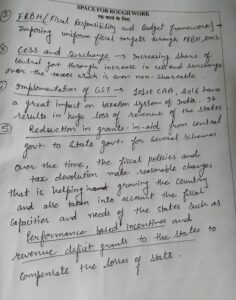Consider the extent to which the Union administration uses Article 356 (President’s Rule) and other emergency powers to control and coordinate the operations of the States. Talk about the arguments for and against using these clauses appropriately.
The autonomy of local self-government institutions, such as Panchayats and Municipalities, within India's federal framework is enshrined in the Constitution through the 73rd and 74th Constitutional Amendments. These amendments aimed to decentralize governance and empower local bodies to promote demoRead more
The autonomy of local self-government institutions, such as Panchayats and Municipalities, within India’s federal framework is enshrined in the Constitution through the 73rd and 74th Constitutional Amendments. These amendments aimed to decentralize governance and empower local bodies to promote democratic participation and socio-economic development at the grassroots level. However, the devolution of powers to these institutions has faced several challenges and debates.
Provisions for Local Self-Government Autonomy
Panchayats (73rd Amendment Act, 1992)
Three-Tier System:
Village Level (Gram Panchayat), Intermediate Level (Panchayat Samiti), and District Level (Zila Parishad).
Elections:
Direct elections to all seats in Panchayats at all levels (Article 243C).
Reservation of Seats:
Reservation for Scheduled Castes (SCs) and Scheduled Tribes (STs) in proportion to their population.
Reservation of one-third of seats for women (Article 243D).
Powers and Responsibilities:
State legislatures to endow Panchayats with the powers and authority necessary to function as institutions of self-government (Article 243G).
Preparation of plans for economic development and social justice.
Implementation of schemes for economic development and social justice.
Finance:
Constitution of State Finance Commissions to review the financial position of Panchayats and recommend measures to improve their finances (Article 243-I).
Municipalities (74th Amendment Act, 1992)
Three Types of Municipalities:
Nagar Panchayat for a transitional area (rural to urban).
Municipal Council for a smaller urban area.
Municipal Corporation for a larger urban area (Article 243Q).
Elections:
Direct elections to all seats in Municipalities (Article 243R).
Reservation of Seats:
Reservation for SCs and STs in proportion to their population.
Reservation of one-third of seats for women (Article 243T).
Powers and Responsibilities:
State legislatures to endow Municipalities with the powers and authority necessary to function as institutions of self-government (Article 243W).
Preparation of plans for economic development and social justice.
Implementation of schemes for economic development and social justice.
Finance:
Constitution of State Finance Commissions to review the financial position of Municipalities and recommend measures to improve their finances (Article 243Y).
Challenges and Debates Surrounding Devolution of Powers
Inadequate Devolution of Powers:
State Control: Many states have been reluctant to devolve significant powers, functions, and resources to Panchayats and Municipalities, maintaining substantial control over these bodies.
Unfunded Mandates: Local bodies are often assigned responsibilities without adequate financial resources, leading to ineffective functioning.
Capacity and Training:
Administrative Capacity: Local bodies frequently lack the administrative capacity and skilled personnel needed to effectively discharge their responsibilities.
Training: There is a need for comprehensive training programs for elected representatives and functionaries to enhance their capabilities.
Financial Autonomy:
Revenue Generation: Local bodies have limited sources of revenue and rely heavily on grants from state and central governments.
State Finance Commissions: Recommendations of State Finance Commissions are often not implemented effectively, undermining the financial autonomy of local bodies.
Political Interference:
Interference by State Governments: Excessive interference by state governments in the functioning of local bodies undermines their autonomy and effectiveness.
Partisan Politics: Local governance is sometimes influenced by partisan politics, affecting the neutrality and efficiency of local institutions.
Implementation of Plans:
Coordination: Lack of coordination between various levels of government (central, state, and local) hampers the effective implementation of development plans and schemes.
Monitoring and Accountability: Weak mechanisms for monitoring and accountability lead to inefficiencies and corruption.
Inclusivity and Representation:
Social Inclusion: Ensuring effective participation and representation of marginalized communities, including women, SCs, STs, and OBCs, remains a challenge.
Awareness: Low levels of awareness and participation among citizens about the roles and functions of local bodies reduce their effectiveness.



The role of the Union government in regulating and coordinating the functioning of the States, particularly through the use of Article 356 (President's Rule) and other emergency powers, is a complex and often debated issue in India's federal structure. Use of Article 356 (President's Rule): ArticleRead more
The role of the Union government in regulating and coordinating the functioning of the States, particularly through the use of Article 356 (President’s Rule) and other emergency powers, is a complex and often debated issue in India’s federal structure.
Use of Article 356 (President’s Rule):
Other Emergency Powers:
Debates and Suggestions:
Overall, the Union government’s ability to regulate and coordinate the functioning of states through emergency powers is a critical aspect of India’s federal structure, but one that requires a delicate balance between national interests and state autonomy, with robust safeguards against potential misuse.
See less